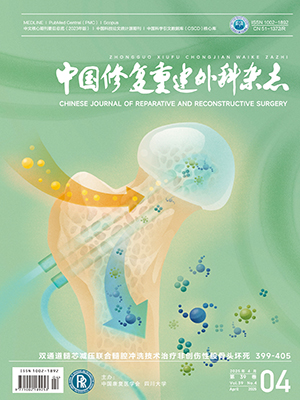Objective To evaluate the effectiveness of unsupported reduction ascending aortoplasty for dilatation of the ascending aorta. Methods Between September 2005 and May 2011, 53 patients with aortic valve disease and dilatation of the ascending aorta underwent aortic valve replacement with unsupported reduction ascending aortoplasty. There were 41
males and 12 females, aged 22-75 years (mean, 52 years). The disease duration was 1 month to 14 years. The color Doppler echocardiography showed that the diameter of the ascending aorta before surgery was (45.9 ± 3.3) mm; bicuspid aortic valve and tri-aortic valve were observed in 13 and 40 cases respectively. The heart functions were graded as II level in 19 cases, III level in 33 cases, and IV level in 1 case according to the standard of New York Heart Disease Academy (NYHA). Results After operation, mediastinum errhysis occurred in 1 case, pneumonia in 3 cases, and III degree atrioventricular block in 1 case. There was no related complication of the aortoplasty. All the patients were followed up 3-68 months (mean, 15 months), and had no obvious chest tightness and palpitation. At last follow-up, the NYHA heart functions were graded as I level in 22 cases, II level in 31 cases; the diameter of the ascending aorta was (35.2 ± 4.0) mm, showing significant difference when compared with the preoperative one (P=0.000), but no significant difference when compared with the one at discharge (34.0 ± 2.5) mm (P=0.245). There was significant difference in the diameter of the ascending aorta between last follow-up and preoperation, at discharge in the patients who were followed up more than 60 months (P lt; 0.05); significant difference was found between last followup and preoperation in patients with bicuspid aortic valve (P lt; 0.05), but no significant difference between last follow-up and preoperation (P gt; 0.05) in patients whose diameter of the ascending aorta was more than 50 mm before operation. Conclusion Unsupported reduction ascending aortoplasty has good short- and mid-term results in treating aortic valve disease with mild to moderate dilatation (diameter range, 40-50 mm) of the ascending aorta. Inclusion criteria of the aortoplasty should be strict. Long-term results need further follow-up.
Citation: LI Yang,MENG Wei,ZHANG Eryong.. CURATIVE EFFECT ANALYSIS OF UNSUPPORTED REDUCTION ASCENDING AORTOPLASTY FOR DILATATION OF ASCENDING AORTA. Chinese Journal of Reparative and Reconstructive Surgery, 2012, 26(7): 819-822. doi: Copy
Copyright © the editorial department of Chinese Journal of Reparative and Reconstructive Surgery of West China Medical Publisher. All rights reserved




